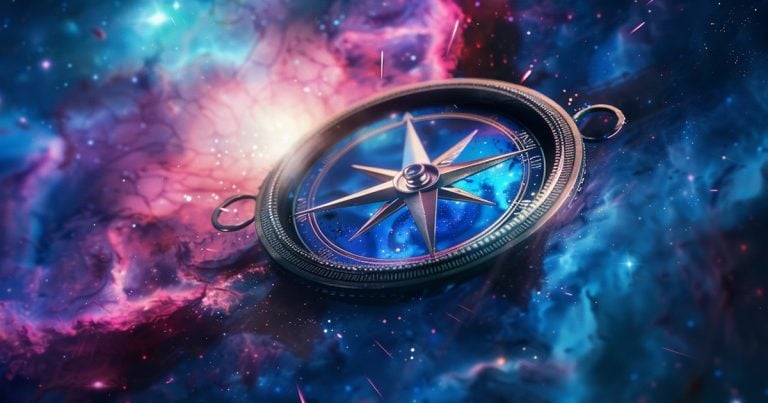Explore the Wonders of the Circinus Constellation
Modified: August 27, 2024 Author: International Star Registry
The Circinus Constellation means “compass” in Latin. It’s a small, southern constellation not well-known to most sky watchers. Named after the tool navigators use, it’s full of cosmic wonders to find.
In the 18th century, French astronomer Nicolas-Louis de Lacaille discovered the Circinus Constellation. It’s a stunning part of the Southern Hemisphere’s night sky. With its rich history and captivating beauty, it’s a favorite for people who love looking at the stars.

Key Takeaways:
- The Circinus Constellation, meaning “compass” in Latin, is a small southern constellation named after the navigational instrument.
- French astronomer Nicolas-Louis de Lacaille first introduced the Circinus Constellation in the 18th century.
- The Circinus Constellation is known for its rich history, mythology, and celestial beauty.
- Located in the Southern Hemisphere, the Circinus Constellation offers a unique and captivating sight in the night sky.
- This constellation remains relatively unexplored, holding a treasure trove of cosmic wonders waiting to be discovered.
A Closer Look at Circinus’ Stars and Deep-Sky Objects
Circinus is located in the southern hemisphere. It is full of interesting stars and deep-sky objects. These have fascinated astronomers and stargazers. We will explore the celestial wonders in Circinus.
The Stars of Circinus
Alpha Circini is a shining star in Circinus. It is a magnitude 3.18 white giant star. This star is about 170 light-years away from Earth. It brightens the night sky, adding beauty to the stars around it.
Beta Circini is a binary star system in the constellation. It has two stars that orbit each other. This system has a combined magnitude of 4.07. It is a beautiful sight for those who love looking at the sky.
Circinus Galaxy: A Barred Spiral Marvel
The Circinus Galaxy is the main star of Circinus. It is about 13 million light-years away. This barred spiral galaxy is unique and full of interesting details. It has caught the attention of astronomers for its special features.
When you see the Circinus Galaxy, you will be amazed. Stars and gas form a stunning picture in space. Its spiral arms have bright stars, and a central bar gives it a graceful structure.
The Circinus constellation has many secrets to share. We will learn more about its stars and deep-sky objects. Stay with us to discover Circinus in more detail soon.
The Mythology and Significance of Circinus Constellation
Unlike many constellations with old stories, the Circinus Constellation is newer. Nicolas-Louis de Lacaille first named it. Circinus celebrates the drive to explore and find new things. Even without ancient myths, it is very important in the study of stars.
The beauty of Circinus in the night sky is special. It is seen best from the southern hemisphere. This makes it a star group that many enjoy learning about and watching.
Circinus is both a big deal in science and in our personal lives. Scientists look at its stars to learn about the universe. And, for those who love space, it’s really inspiring.
Did you know you can name a star in Circinus? International Star Registry lets you do this. Naming a star can be a great gift for any special moment.
The story of Circinus is more about its science and connections we can make with it. It stands out because of how it inspires both experts and those who love looking at the stars.
Viewing and Observing Circinus in the Night Sky
Circinus is south of the celestial equator. It shines bright in the southern night sky. Some may find it hard to spot because of its size and faint stars. But, its beauty draws in those who love to explore the stars.
To see Circinus, go to the Southern Hemisphere or low Northern latitudes. It’s best seen in late spring. For the best view, use a star chart and get away from city lights.
The shiniest star in Circinus is Alpha Circini. It has a magnitude of 3.19 and is 53 light-years from us. Its bright light calls out to anyone looking up at the night sky.
Beta Circini is the second brightest star in Cirinus. It’s about 7 1/2 degrees from Alpha Circini. With a magnitude of 4.07, it sits 97 light-years away from Earth.
There are more than just stars to see in Circinus. The NGC 5823 open cluster, with its 7.9 magnitude, is a beautiful sight through a telescope. Not far is NGC 5715, another open cluster, with a magnitude of 10.
Want to learn more about the Circinus constellation? Check out EarthSky, Constellation Guide, and The Sky Live. They have tips and insights for a better stargazing experience.

The Historical Overview of the Circinus Constellation
The Circinus constellation has a special place in astronomy history. French astronomer Nicolas-Louis de Lacaille first mapped it in the 18th century. He was charting the southern sky and named it after a drafting tool for drawing circles.
Lacaille’s work helped people understand the stars in the Southern Hemisphere better. In 1930, the International Astronomical Union declared his constellations official. This included Circinus, ensuring its role in astronomy was recognized.
Exploring the myths and science behind Circinus adds to its wonder. Its name and place in the sky were carefully chosen. This makes it more fascinating for those looking at the stars.
The Circinus constellation’s rich history and beauty welcome everyone to learn more about it. It doesn’t matter if you’re an expert or just like looking at the sky. Circinus’ story will interest you and make you feel closer to the universe.
For a look at Circinus and its beauty, check out the stunning image below:
Join us as we learn more about Circinus’ mysteries in the next part. In Section 6, we’ll discover what’s hidden in this constellation. Get ready for some exciting finds and a deeper look at the universe in Circinus.
Deep-Sky Objects and Celestial Wonders in Circinus
Circinus is a constellation full of amazing things. It’s a place where both stargazers and scientists can find joy. Here, you can see many deep-sky objects that show us more about the universe.
In Circinus, you’ll find something very special called Circinus X-1. It is an X-ray binary star system. This system shoots out strong X-rays. These X-rays help us learn about black holes and their workings. Looking at Circinus X-1 lets us see the sheer power and beauty of our universe.
NGC 5315: A Celestial Gem
NGC 5315 is deep in Circinus. It’s a stunning planetary nebula that formed from a dying star. This celestial beauty shows off lovely gas and dust patterns. These are lit up by the star at its heart. Looking at NGC 5315 is like seeing a big light show that reminds us how vast and beautiful our universe is.
To really understand Circinus, take time to look at its deep-sky objects. They make this part of the sky even more interesting. Plus, they add to its long history and myths.
Dive into Circinus and let its deep-sky objects spark your curiosity about space. As you look at these wonders, you’ll start to value the secrets of the universe. It’s a cool way to learn more about the big world beyond our little home.
The Most Prominent Stars in the Circinus Constellation
The Circinus Constellation might be dim, but it’s full of wonders. Its main stars stand out in the southern night sky.
Alpha Circini is at the center, shining the brightest. It gleams with an apparent magnitude of 3.19. Even though it’s 53.5 light-years away, we can see its glow in the sky.1
Beta Circini, the second star, is a white dwarf that shines with a 4.07 magnitude. Being farther at 100 light-years, it still lights up the constellation’s view.1,20
Completing the trio is Gamma Circini. It’s not as bright but it adds to Circinus’ beauty. Together, these stars make Circinus an unforgettable part of our night sky.1

Learn more about the Circinus Constellation and its stars on Wikipedia and Go Astronomy sites.
Next, we’ll explore the myth and importance of the Circinus Constellation. Stay with us!
References:
- Wikipedia: Circinus
- Go Astronomy: Circinus Constellation
Name a Star in Circinus with International Star Registry
Name a star in the Circinus constellation with International Star Registry. It’s a great way to make a special, lasting connection. Buying a star gives you a unique and memorable gift option that lasts a lifetime. You may name a star after someone special, mark a big event, or just enjoy the beauty of the skies. International Star Registry lets you leave your mark in the stars.
While Circinus may lack ancient myths, it doesn’t diminish its allure or significance. In fact, its modern history and celestial beauty make it an ideal canvas for creating personal connections and meaningful gestures. One such gesture is naming a star in the Circinus constellation.
Through International Star Registry, you have the opportunity to immortalize your loved ones, commemorate special occasions, or simply indulge in the magic of the cosmos by naming a star in Circinus. Whether it’s a birthday, Christmas, anniversary, or any other milestone, naming a star is a timeless and heartfelt gift that will shine brightly for generations to come.
At starregistry.com, you can buy a star in Circinus with ease and convenience. Simply choose your preferred star package, personalize your star certificate with a heartfelt message, and watch as your star becomes a beacon of light in the night sky.
Get started with International Star Registry and buy a star for someone.
Embracing the Boundless Beauty of Circinus Constellation
The Circinus constellation is truly special. It has drawn the eyes of many, from astronomers to those who love to look at the stars. It’s a stunning sight with a deep history. This constellation was named by French astronomer Nicolas-Louis de Lacaille. He was exploring the Cape of Good Hope in the 18th century. The constellation continues to amaze us with its features today.
One special part of the Circinus constellation is Alpha Circini, its brightest star. It’s about 53 light-years away from us. This star lights up the sky and reminds us of the vast universe we live in.
The Circinus Galaxy is also part of this constellation. It’s a barred spiral galaxy about 13 million light-years from us. This galaxy’s beauty and structure remind us of the wonders of space.
Have you ever thought about having a star in the Circinus constellation named after you or someone you love? International Star Registry can make this dream come true. It offers a chance to name a star in Circinus for special occasions like birthdays or anniversaries. It’s a unique gift that represents love and lasting memories.
The Circinus constellation’s beauty helps us feel connected to the universe. It brings us joy as we learn about its stories, see its stars, and explore its deep-sky objects. Circinus shows us the amazing and beautiful parts of astronomy.
Next time you’re under the stars, take a minute to look at Circinus. Let this beautiful constellation spark your interest in the universe’s mysteries. It’s a doorway to the wonder of astronomy.
Sources: International Star Registry, Qubesky – Summer Constellations, “Everyday Objects” – Project Gutenberg
Conclusion
The Circinus Constellation takes us on a journey rich in history, stories, and celestial beauty. Its stars, deep-sky objects, and meanings today all make it special. It encourages us all to explore the universe’s mysteries and beauty.
Across time, the Circinus Constellation has intrigued people with its myths and astronomy. From old times to now, it remains a key part of how we see the universe. Looking at its deep-sky objects and stars, we see the universe’s endless vastness.
Looking for a unique gift or a special way to celebrate? Consider naming a star in the Circinus Constellation. International Star Registry lets you officially name a star there. It’s a perfect gesture for someone you care about or for yourself, lasting in meaning.
Feel the magic of the Circinus Constellation – a mix of tales, history, and celestial marvels. Its beauty and mysteries are waiting for you to discover. Whether you observe or name a star, Circinus draws you in to a world of awe and wonder beyond our own.
FAQ
What is the Circinus Constellation?
The Circinus Constellation is a small southern one. It’s named after a tool for drawing circles. The draftsmanship comes from French astronomer Nicolas-Louis de Lacaille from the 18th century.
What are some noteworthy stars and deep-sky objects in Circinus?
Notable stars in Circinus include Alpha and Beta Circini. The brightest is Alpha Circini. Beta Circini is a pair of stars. The captivating Circinus Galaxy is a star as well, located about 13 million light-years away.
Is there any mythological significance associated with Circinus?
Circinus doesn’t have ancient myths like many constellations do. Its myth highlights the spirit of exploration and finding new things. It’s all about making important connections and gestures.
When and how can I view Circinus in the night sky?
Circinus is best seen from the Southern Hemisphere and lower Northern latitudes. It’s great to view in late spring. To find it, use a star chart and go where the skies are dark. This is due to the small size and faintness of its stars.
What is the historical background of the Circinus Constellation?
Named by Nicolas-Louis de Lacaille in the 18th century, Circinus comes from the Latin for drafting tool. His work in mapping the Southern Hemisphere led to its creation. The International Astronomical Union recognized this and his other constellations in 1930.
What are some notable deep-sky objects in Circinus?
Deep-sky objects in Circinus include Circinus X-1, a binary star producing X-rays. NGC 531, a planetary nebula is formed from a dying star. These objects show the diverse wonders in Circinus.
Which are the most prominent stars in the Circinus Constellation?
The key stars in Circinus are Alpha, Beta, and Gamma Circini. Alpha is a variable star around 53.5 light-years away. Each of these stars plays a unique role in the constellation.
Can I name a star in the Circinus Constellation?
Yes, you can name a star in Circinus via International Star Registry. It’s a beautiful way to celebrate a special time, remember a loved one, or find joy in the cosmos. Go to starregistry.com to see your options and craft a star certificate.
What can I learn about astronomy from the Circinus Constellation?
The Circinus Constellation opens a door to astronomy. It offers a rich history and a chance to understand the universe. Exploring its wonders is both rewarding and full of mystery.
Source Links
- Circinus Constellation | Star Map & Facts – https://www.go-astronomy.com/constellations.php?Name=Circinus
- Circinus – https://www.starregistry.com/constellation-name/circinus/
